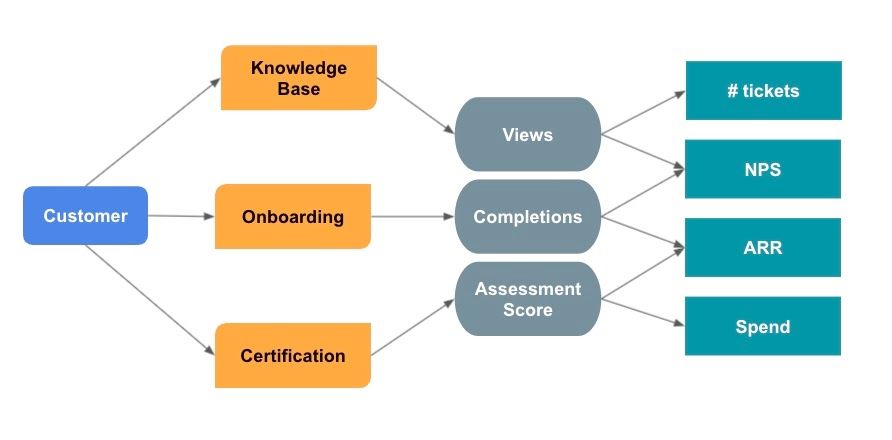Where it all began
Intellum has been an innovator in the corporate education space since we launched the world’s first cloud LMS in 2000.
Over many years of working with some of the largest companies to deliver their educational programs at scale, we recognized a pattern in the structure of the most successful programs.
In 2019, at Intellum’s IXS conference, we unveiled the first ever corporate education playbook that outlined the must-haves to achieve success. Over the following year we gathered input from the sharpest minds in the industry and refined the playbook, which became known as the Intellum Methodology.
The Intellum Methodology
The Intellum Methodology includes eight key strategic pillars that make up a successful education strategy: business goals, audience strategy, resources, content strategy, delivery strategy, marketing strategy, measurement, and application.
The most successful education programs display mature execution in each of these areas. We’ll briefly look at each one:
Business goals
Educational initiatives should tie back to specific, measurable, relevant, and achievable business goals. Additionally, it should be true that education specifically can effectively influence the desired goal.
Audience strategy
Successful education program developers understand their audience, including segmentation and learner personas. A learner persona is not the same as a marketing persona; it includes learning-specific information such as learner goals, challenges, and motivation.
Resources
Educational initiatives require specialty skills such as education strategy, learning experience development, and instructional design, in addition to project management, marketing, and technical/engineering support. Successful programs have dedicated resources to support these functions.
Content strategy
The content must directly support the learner goals and business goals to be effective. There should be a purposeful content structure (curricula), relevant taxonomy, assessments, and a feedback loop.
Delivery strategy
Content is only as good as the delivery of the content. The delivery strategy should consider the end-to-end learning journey. Essentially we need to get the right content to the right learner at the right time in the right way.
Marketing strategy
Education marketing is a discipline in and of itself. The educational program should be treated as a product, requiring a go-to-market plan as well as engagement and re-engagement tactics.
Measurement
There are three levels of measurement for any education program: engagement, content efficacy, and business impact. The most successful programs are reporting on all three and demonstrating business impact.
Application
The audience has been identified, the content delivered, and the performance measured. Now what? Application is the final piece that ties all of the learnings back to the original business goal(s).
We were quite excited to land upon such a valuable methodology.
We began sharing it with all of our clients and interested parties. Soon, though, the question of “how do I apply this methodology?” began rolling in from all angles.
There was no question that the methodology made sense, but what was that next step in moving it from theory to practice?
When you first look at the methodology, it appears fairly straightforward. You need a business goal, an audience, delivery of content, and then measurement and application of results.
The challenge, however, is that line of thinking assumes a one-to-one ratio of all items - one goal, one audience, one content type, etc. For anyone that has worked in corporate education, you know that is rarely, if ever, the case.
We’re generally working on multiple goals, reaching many audience segments, employing a variety of content initiatives, delivering via multiple modalities, and measuring results using many different metrics.
The challenge is further exacerbated when we consider that often, especially in larger companies, many individuals across different teams are working on education initiatives. This may include an internal learning and development team, a product training team, customer success education, partner certification, and so on.
We also found that it was quite common (and generally recommended) for all of these teams to use one education platform to deliver their material to their audience.
Now if you have many goals, audiences, content types, modalities, and metrics, and many different people and teams working on it all, the only way to really apply a consistent and holistic methodology, all while keeping stakeholders aligned, is with the use of a strategic framework.
The birth of a new framework
Every successful organization employs a strategic framework to align the business around a central strategy. If you’ve never been in a corporate planning or strategy role, you might wonder, what is a strategic framework? HDI succinctly defines it as "a structured method used to define how a project or initiative supports the key objectives of stakeholders."
There are a number of popular frameworks out there, such as the balanced scorecard, the VRIO framework, and the Ansoff matrix. They all have unique uses and different ways of organizing initiatives. For example, the Ansoff matrix is also known as a product/market expansion grid and is best used to grow an existing business.
The VRIO framework, on the other hand, is used to analyze existing internal resources toward developing a competitive advantage.
What these frameworks have in common is their ability to capture all of an organization's activities, strategies, and goals in one central map that can be used to align key stakeholders across the company. Do you see where we might be going with this?
The most common strategic frameworks focus on an organization’s overall business strategy. We found, however, that education strategy is a bit nuanced and doesn’t fit perfectly with any existing framework. So, we developed our own.
The Intellum Framework Ⓒ is one that leverages our own methodology and unites all of an organization’s educational initiatives in one central document, ultimately leading to a strategy map that demonstrates the education’s anticipated business impact.

The Intellum Framework is composed of several worksheets that capture an organization’s educational initiatives from three perspectives: goals, audiences, and content. It’s then used to map the three perspectives together to tell the story of business impact.
The Intellum Framework course is here. Let’s walk through it together!



